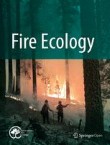Fire Ecology is the official journal of the Association for Fire Ecology.
Wildfire Consumption and Interannual Impacts by Land Cover in Alaskan Boreal Forest
Boreal forest fires are an important source of terrestrial carbon emissions, particularly during years of widespread wildfires. Most carbon emission models parameterize wildfire impacts and carbon flux to area...
